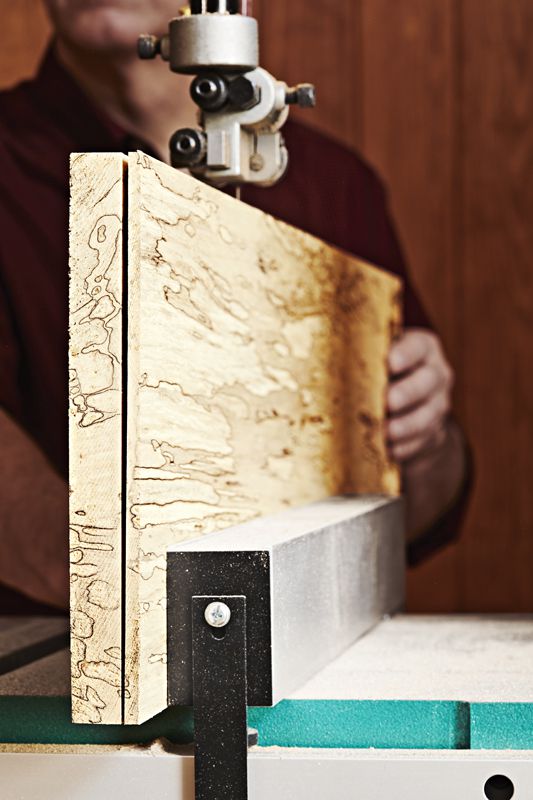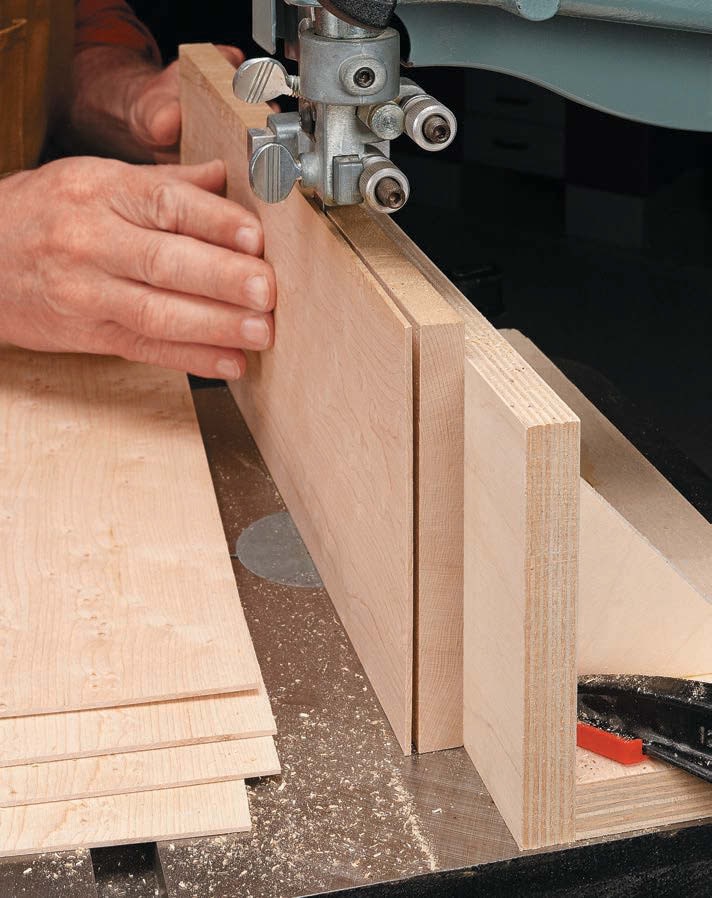Are you wondering what the best size bandsaw blade is for resawing? Well, you’ve come to the right place! Choosing the right bandsaw blade size is crucial for getting clean and accurate cuts when resawing wood. So let’s dive in and explore the ins and outs of finding the perfect blade for this task.
Resawing is the process of cutting a thick piece of wood into thinner pieces, often used for making veneers or bookmatching. But here’s the thing: not all bandsaw blades are created equal when it comes to resawing. The blade size plays a key role in determining the quality of your cuts. And that’s exactly what we’ll be uncovering in this guide.
So whether you’re a woodworking enthusiast or a seasoned pro, stick around to discover the best size bandsaw blade for resawing and take your woodworking projects to a whole new level!

What is the Best Size Bandsaw Blade for Resawing?
Resawing is the process of cutting a thick piece of wood into thinner boards using a bandsaw. It is a popular technique among woodworkers for creating bookmatched panels, veneers, and maximizing the use of lumber. To achieve precise and clean resaw cuts, choosing the right bandsaw blade is crucial. In this article, we will explore the factors to consider when selecting the best size bandsaw blade for resawing and provide detailed information to help you make an informed decision.
Factors to Consider When Choosing a Bandsaw Blade:
1. Blade Width:
The width of the bandsaw blade plays a significant role in the resawing process. It determines the size of the cut and the accuracy of the resulting boards. Generally, wider blades, such as 3/4″ or 1″ blades, are preferred for resawing as they provide more stability and reduce the risk of blade drift. However, narrower blades, like 1/2″ or 3/8″ blades, can be used for thinner cuts or smaller projects.
2. TPI (Teeth Per Inch):
The TPI refers to the number of teeth on the blade. It affects the speed and smoothness of the cut. For resawing, a lower TPI, such as 2-3 TPI, is recommended. This lower tooth count removes material more efficiently and reduces the chances of the blade getting clogged with sawdust. Higher TPI blades (around 6-10 TPI) are better suited for fine cutting tasks.
3. Tooth Pattern:
The tooth pattern of a bandsaw blade can vary, and different patterns are suitable for different applications. For resawing, a hook tooth pattern is often preferred. This pattern features deep, wide gullets that help clear out sawdust, preventing it from interfering with the cut. The hook tooth pattern also helps reduce heat buildup and prolongs the blade’s lifespan.
Blade Width Options for Resawing:
When it comes to choosing the best size bandsaw blade for resawing, there are a few width options to consider. Let’s delve into the details:
3/4″ Bandsaw Blade:
A 3/4″ bandsaw blade is a popular choice for resawing. Its wider width provides stability and reduces the risk of blade drift, ensuring straight and accurate cuts. This blade can handle thicker stock and is suitable for cutting larger boards or panels.
One benefit of using a 3/4″ blade is its ability to dissipate heat better, which helps prevent overheating and blade damage during the resawing process. Additionally, the wider blade allows for more efficient chip removal, resulting in cleaner and smoother cuts.
However, it’s essential to consider the power and capacity of your bandsaw machine when using a 3/4″ blade. Ensure that the bandsaw can handle the width and has sufficient tensioning capability to achieve optimal results.
1/2″ Bandsaw Blade:
While a 3/4″ blade is commonly used, a 1/2″ bandsaw blade can be a suitable option for resawing thinner stock or when making smaller cuts. The narrower blade can handle curves more effectively and provides better control in intricate resawing tasks.
When using a 1/2″ blade, it’s important to be aware of its limitations in terms of stability and feed rate. Thicker or wider stock may be more challenging to handle, and the narrower blade may require more passes to achieve the desired thickness. However, for finer and more detailed resawing projects, a 1/2″ blade can be a valuable tool.
1″ Bandsaw Blade:
Benefits of Using a 1″ Blade:
Considered the wider option for resawing, a 1″ bandsaw blade offers increased stability, reduced blade drift, and improved control during the cutting process. It is particularly useful when working with larger and denser materials, such as hardwoods or exotic woods.
The 1″ blade can handle thick stock with ease, allowing you to efficiently resaw boards to the desired thickness. It provides more surface area in contact with the wood, resulting in improved accuracy and reduced vibration, which can lead to smoother cuts.
When choosing a 1″ blade, ensure that your bandsaw machine has enough power and tensioning capacity to accommodate the wider size. The increased tension required for a 1″ blade may necessitate adjustments and proper setup to achieve optimal performance.
Tips for Optimal Resawing:
1. Blade Tension: Ensure that the bandsaw blade is properly tensioned to prevent fluttering and wandering during the resawing process. Follow the manufacturer’s guidelines for recommended tension settings.
2. Blade Tracking: Regularly check the blade tracking to ensure it is aligned properly. Improper tracking can result in uneven cuts and premature blade wear.
3. Feed Rate: Take your time when feeding the wood into the bandsaw. A slow and steady feed rate allows the blade to cut smoothly and reduces the risk of blade drift.
4. Blade Maintenance: Keep the bandsaw blade sharp and clean. Dull blades can result in rough cuts and may cause overheating. Clean out sawdust regularly to prevent it from interfering with the cut.
By considering these factors and using appropriate bandsaw blade sizes, you can achieve precise and smooth resawing results. Selecting the best size bandsaw blade for resawing should be based on the thickness of the stock, the intricacy of the cuts, and the capacity of your bandsaw machine.
Key Takeaways: What is the Best Size Bandsaw Blade for Resawing?
- 1. Choose a bandsaw blade with a width between 1/2 inch and 1 inch for optimal resawing performance.
- 2. Opt for a blade with a low tooth count, such as 3 to 4 TPI (teeth per inch), for cutting thick stock during resawing.
- 3. Consider the thickness of the material you’ll be resawing when selecting the blade width and tooth count.
- 4. Use a blade with a skip-tooth configuration for faster cutting and chip removal during resawing.
- 5. Always use a sharp and properly tensioned bandsaw blade for the best resawing results.
Frequently Asked Questions
Here are some commonly asked questions about choosing the best size bandsaw blade for resawing:
1. What factors should I consider when choosing a bandsaw blade for resawing?
When selecting a bandsaw blade for resawing, there are a few important factors to consider. First, you’ll want to determine the width and length of the blade that your bandsaw can accommodate. Additionally, the tooth configuration is crucial for resawing. A blade with fewer teeth per inch (TPI) will be better suited for larger, thicker cuts, while a blade with more TPI will provide smoother cuts for smaller, intricate work. Finally, the material of the blade, such as high-carbon steel or carbide tips, can also affect performance and longevity.
Ultimately, finding the best size bandsaw blade for resawing requires considering the dimensions of your bandsaw, the type of cuts you plan to make, and the material of the blade itself.
2. How do I determine the appropriate blade width for resawing purposes?
Choosing the right blade width is crucial for optimal resawing performance. As a general guideline, the blade width should be at least three times the thickness of the material you plan to resaw. For example, if you’re working with a 2-inch thick piece of wood, a blade with a width of 6 inches or more would be suitable.
However, it’s important to note that the specific characteristics of your bandsaw, such as its motor power and wheel diameter, can also influence the maximum blade width it can accommodate. Consult your bandsaw’s manual or manufacturer’s guidelines to ensure you select a blade width that is within the recommended range for your equipment.
3. Can I use any bandsaw blade for resawing, or are there specialized blades available?
While it’s possible to use any bandsaw blade for resawing, there are specialized blades specifically designed for this purpose. These blades, often referred to as “resaw blades,” feature a narrow width and a low TPI count. They are specifically optimized for making smooth, straight cuts through thick pieces of wood. Resaw blades typically have a deeper gullet, which helps remove larger amounts of material during each pass, resulting in more efficient cuts.
While you can still achieve decent resawing results with a regular bandsaw blade, using a dedicated resaw blade will provide superior performance and ensure cleaner, more accurate cuts.
4. What are the advantages of using a wider bandsaw blade for resawing?
Opting for a wider bandsaw blade for resawing offers several advantages. Firstly, a wider blade provides greater stability and reduces the chances of blade deflection, resulting in straighter cuts. The added width also allows for more efficient chip clearance, preventing clogging and promoting smoother cutting performance.
Furthermore, a wider blade typically has more teeth, which can lead to improved surface finish and reduced sanding requirements. The increased surface area of the blade also helps dissipate heat, prolonging the blade’s lifespan. Overall, using a wider bandsaw blade can enhance both the accuracy and efficiency of your resawing projects.
5. How often should I change the bandsaw blade when resawing?
The frequency at which you need to change your bandsaw blade when resawing can vary depending on several factors. The type of material you’re cutting, the blade’s quality, and the intensity of your cutting tasks can all influence blade durability. However, as a general guideline, it’s advisable to inspect your blade regularly and replace it whenever you notice signs of wear, such as dullness, missing teeth, or excessive vibrations.
Keep in mind that maintaining a sharp and properly tensioned blade is crucial for achieving clean, smooth resawing cuts. If you notice a significant decrease in cutting performance or notice any issues with your cuts, it’s likely time to change the blade. Regular blade changes will not only ensure optimal cutting results but also prolong the life of your bandsaw and prevent potential accidents caused by a worn-out blade.

The only 3 bandsaw blades you need
Summary
When it comes to choosing a bandsaw blade for resawing, there are a few important factors to consider. First, the blade width should be at least 3/4 inch or wider to handle the tension and pressure of cutting through thick wood. Additionally, a blade with fewer teeth per inch (TPI) will be ideal for resawing. A lower TPI will allow for faster cutting and prevent overheating. Remember to choose a blade made of high-quality materials for durability and smooth cuts. Finally, proper blade tension and regular maintenance are crucial for achieving the best results when resawing.
In conclusion, selecting the right size bandsaw blade for resawing involves choosing a wide blade with fewer teeth per inch. By following these guidelines and ensuring proper tension and maintenance, you can achieve successful and precise resawing cuts in your woodworking projects. Happy sawing!
